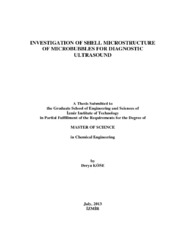Please use this identifier to cite or link to this item:
https://hdl.handle.net/11147/3591Full metadata record
| DC Field | Value | Language |
|---|---|---|
| dc.contributor.advisor | Kılıç Özdemir, Sevgi | en |
| dc.contributor.author | Köse, Derya | - |
| dc.date.accessioned | 2014-07-22T13:51:53Z | - |
| dc.date.available | 2014-07-22T13:51:53Z | - |
| dc.date.issued | 2013 | en |
| dc.identifier.uri | http://hdl.handle.net/11147/3591 | - |
| dc.description | Thesis (Master)--Izmir Institute of Technology, Chemical Engineering, Izmir, 2013 | en |
| dc.description | Includes bibliographical references (leaves: 95-101) | en |
| dc.description | Text in English; Abstract: Turkish and English | en |
| dc.description | xiii, 101 leaves | en |
| dc.description | Full text release delayed at author's request until 2016.08.02 | en |
| dc.description.abstract | In this study we reported the effect of shear stress, protein adhesion, temperature, secondary interactions and gas core on microbubble stability which are the main reasons of microbubble dissolution in body. Air filled DSPC/PEG40St microbubbles were examined under shear stress. Increasing PEG40St molar ratio increased the resistivity microbubbles against shear stress. To investigate effect of emulsifier type, microbubbles were produced by mixing DSPC with DSPE-PEG1000, DSPE-PEG2000 and PEG40St at 5:5 molar ratio and PEG40St microbubbles were more stable since it provide better curvature to microbubble shell due to its shape. Shear stress experiments were also performed at different temperatures. With increasing temperature microbubbles became less stable since van der Waals interactions between shell components decreased. When microbubbles were filled with perfluorocarbon, since its solubility is lower and more hydrophobic than air, the stability of microbubbles against shear stress increased. Protein adhesion to microbubble shell was investigated by Langmuir Blodgett (LB) and Surface Plasmon Resonance techniques. Both techniques showed that, as the PEG40St molar ratio and packing density increased, protein adhesion decreased. Secondary interactions between shell components were examined via LB technique and visualized via Brewster Angle Microscopy. As third component to DSPC/PEG40St mixture, StGly, StNH2, DSPS, DSTAP was added and ternary mixtures were generally miscible. Since StGly and StNH2 has single tail, they cannot provide curvature in bubble surface. DSPS and DSTAP mixtures may be recommended drug delivery. | en |
| dc.language.iso | en | en_US |
| dc.publisher | Izmir Institute of Technology | en |
| dc.rights | info:eu-repo/semantics/openAccess | en_US |
| dc.subject.lcsh | Microbubbles | en |
| dc.subject.lcsh | Ultrasonic imaging | en |
| dc.subject.lcsh | Nanotechnology | en |
| dc.title | Investigation of shell microstructure of microbubbles for diagnostic ultrasound | en_US |
| dc.type | Master Thesis | en_US |
| dc.institutionauthor | Köse, Derya | - |
| dc.department | Thesis (Master)--İzmir Institute of Technology, Chemical Engineering | en_US |
| dc.relation.publicationcategory | Tez | en_US |
| item.fulltext | With Fulltext | - |
| item.grantfulltext | open | - |
| item.languageiso639-1 | en | - |
| item.openairecristype | http://purl.org/coar/resource_type/c_18cf | - |
| item.cerifentitytype | Publications | - |
| item.openairetype | Master Thesis | - |
| Appears in Collections: | Master Degree / Yüksek Lisans Tezleri | |
Files in This Item:
| File | Description | Size | Format | |
|---|---|---|---|---|
| 10011378.pdf | MasterThesis | 9.6 MB | Adobe PDF |  View/Open |
CORE Recommender
Page view(s)
590
checked on Nov 18, 2024
Download(s)
582
checked on Nov 18, 2024
Google ScholarTM
Check
Items in GCRIS Repository are protected by copyright, with all rights reserved, unless otherwise indicated.